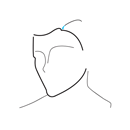Afro, curly and wavy hair gives better coverage than straight Caucasian type of hair for various reasons.
In some cases there may still a good density of hair, however, the reflection of light on the scalp through the thin miniaturised hair may make the person look bald even though he/she is not. When this is the case we talk about a loss in calibre not in density.
Hence, the main challenge of a successful hair transplant lies in creating an optical illusion of good coverage in the recipient area.
Understanding the difference between density and calibre is important when deciding on the number of grafts transplanted per cm2. The quality of hair to be transplanted is key here. Someone with hair of less calibre may need more grafts to be transplanted than someone with hair of a better calibre.
Therefore, in order to receive a satisfactory result, Dr. Lupanzula decides on the number of grafts to be transplanted based on various factors, such as the diameter of the grafts, the contrast between the skin and the hair, as well as hair texture.




